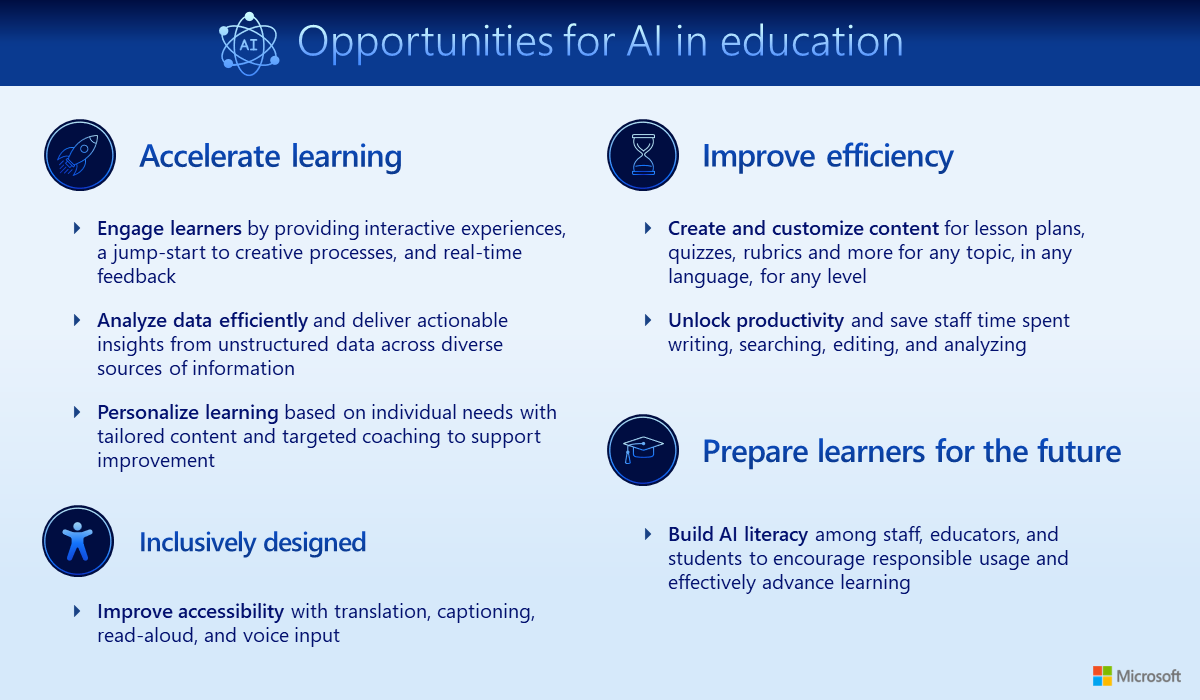AI in education
One role of educators in today's rapidly evolving technological world is to prepare learners for the challenges and opportunities they'll face in their future.
What is AI's role in education?
As generative AI continues to advance and mature, its impact on various industries—including the job market—increases. Today’s learners will enter a workforce where AI hasn't only undergone substantial improvements but also transformed existing careers, created new professions, and reshaped job descriptions.
In a recent Microsoft report, 82% of leaders across several industries say their employees will need new skills to be prepared for the growth of AI (Work trend index). Working alongside AI—using natural language—will be as inherent to how we work as the internet and the PC. When employers are asked which skills are most essential for employees to learn, they put the following at the top of their lists:
- Analytical judgment
- Flexibility
- Emotional intelligence
- Creative evaluation
- Intellectual curiosity
- Bias detection and handling
- AI delegation (prompts)
Skills like critical thinking and analytical judgment, complex problem solving, and creativity and originality are new core competencies—and not just for technical roles or AI experts. Embracing and understanding generative AI and its potential to enhance the world is merely the first step in ensuring that learners are equipped to thrive in their future endeavors.
As educators adopt and incorporate AI technologies into teaching and learning practices, they better prepare learners. By familiarizing learners with AI tools and applications, educators help them to develop critical skills and competencies that are valuable in a wide range of professions.
Tools for educators
AI has the potential to reduce educators’ workloads by automating routine tasks and supporting the creation of resources.
An educator in a secondary class needs to create a rubric for an upcoming writing unit in Greek mythology, then write an exemplar response for learners to follow. Facing what could be hours of work to complete, the educator turns to an AI tool and starts to enter in the prompts. The educator starts with the rubric. They turn to Microsoft Copilot and paste in the state standards and description of the upcoming Greek mythology writing unit. Then, they ask Copilot to create a 20-point rubric including all the information they pasted. It’s completed, but it’s not quite what they were expecting. After interacting with Copilot with a few more clarifying prompts like “Make the wording better for a 13-year-old,” the educator has the rubric. Finally, the educator asks the AI to write an exemplar response based on the rubric it created.
Using a generative AI tool can give educators the gift of time. That saved time can then be used toward curriculum development, individualized instruction, or learner support.
Increase learner engagement
Interactive AI tools can enhance engagement by providing immersive and hands-on learning experiences. These tools bring abstract concepts to life by encouraging active participation and promoting deeper understanding. Furthermore, AI-powered educational games and quizzes can make learning more fun and interactive and increase learner enthusiasm and participation. AI can also assist educators with data-driven decision making. By analyzing learner performance data, AI can help provide opportunities for educators to build upon their existing relationships and differentiate support. It can shine a spotlight on learner activity and allow educators and school communities to use the available data to enhance instruction and connection within the digital learning environment.
